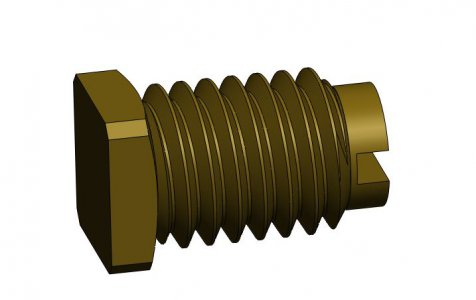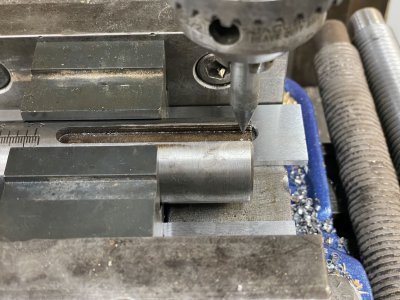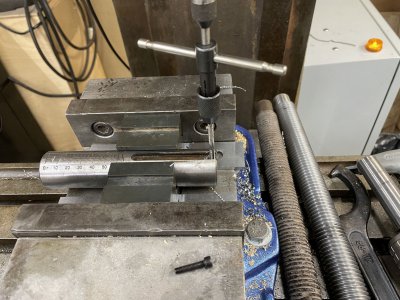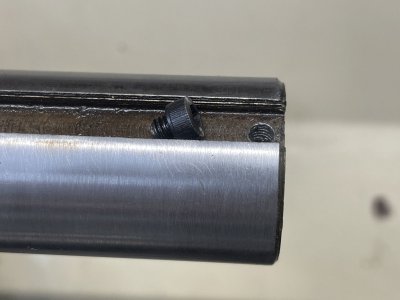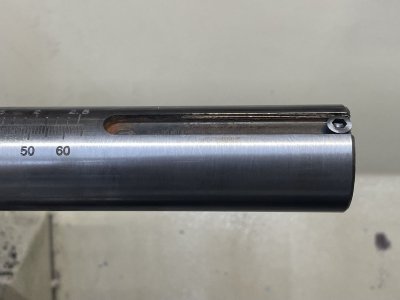The lathe in the story below is a G9972Z, an 11x26 machine that is very much like the 10x22 G0602.
The work was going a little better than the night before. I'm a volunteer on the Battleship USS Texas restoration and my current project is making six new screws for part of the sights on 1912 vintage 5" Naval guns. The screws are about 18" long and 1-1/8" x 7 tpi left hand threads. A Battleship Texas Foundation employee ordered the threaded rod. The salesman said in the 20 years he had worked at that business it was the first time they had sold 1-1/8x7 LH all thread but they had it in stock for only $198.00 for 3 feet. Sorry; that's all irrelevant to the tail stock problem; just had to set the stage. One other detail; the 5" guns have to go back onto the ship in less than 2 weeks while it's still in dry dock because they're big and they weigh about 25,000 pounds each.
Anyway, there I was, making some bushings to replicate a 3/4" thick x 1.5" OD feature on the screws out of some unknown dumpster steel I picked up one day. Actually, I think the material was bolts for attaching the halves of gas turbine generator engines. I got about 9" x 1-1/2" of cleaned up stock out of each bolt. I was drilling one of the pieces and everything was going great, as is customary right before disaster strikes. I was increasing the diameter of the drills 1/16" at a time as that's the horsepower limit for the lathe. I think I was up to the 11/16" bit and the chips were flowing out past the bit. Suddenly everything started spinning. I had run the quill out past the anti-rotation screw. It wasn't the first time so I had a pretty good idea what to do. The usual fix it to take the quill and leadscrew out of the tail stock, oil them and work the screw in and out until it turns smoothly again. Reassemble and go back to what I was doing. Not this time, though!
The screw didn't want to thread back into the quill while in the tail stock. On the bench, I got them to screw back together but the threads were tight. Suddenly, with about 1-1/2" of lead screw in the quill, it locked up tight. The oxygen and acetylene tanks were empty so all I had for heat was a propane torch. Any place selling welding gases had been closed for hours. After a couple of tries to use heat to get the screw out of the quill I decided to let it soak in Kroil. The assembly was clamped in the milling vise vertically and I sprayed Kroil into the quill. I left it to sit and soak. After an hour or so I went back to the shop. This was really troubling because of the short timeline before the ship is put back in the water. I hooked a strap from a light duty cargo strap onto the tail stock hand wheel handle, wrapped the strap over the hand wheel and screw shaft in an unlikely macrame and stuck a large screwdriver through the metal hook of the strap and put the tip against the hand wheel handle. IT BUDGED! Not much, but any movement was good. After a few more attempts and refining the cargo strap winding the screw finally came out. It actually looked OK but the tightness said otherwise. I tried lapping it with Flitz and that seemed to help a little but it still was stiff. Finally, I chucked the screw up in the lathe and chased the threads with a regular file on its corner, being fresh out of left hand metric thread files. There was only a little accumulation of shavings on the file but when I tried the screw in the quill again it worked like new.
THE SOLUTION: I marked the center of the anti-rotation slot as close as I dared to the open end of the slot. I'm drilling and tapping to put a socket head cap screw in that slot so that the quill cannot be accidentally advanced too far. I'll use a metric SHCS if I have one the right size; otherwise it will get an 8-32 with the head cut down a few thou. That will mean that the anti-rotation screw has to be retracted to remove the quill but if this works out well I shouldn't need to remove the quill very often. So far it's only been removed after I ran it out too far.
The work was going a little better than the night before. I'm a volunteer on the Battleship USS Texas restoration and my current project is making six new screws for part of the sights on 1912 vintage 5" Naval guns. The screws are about 18" long and 1-1/8" x 7 tpi left hand threads. A Battleship Texas Foundation employee ordered the threaded rod. The salesman said in the 20 years he had worked at that business it was the first time they had sold 1-1/8x7 LH all thread but they had it in stock for only $198.00 for 3 feet. Sorry; that's all irrelevant to the tail stock problem; just had to set the stage. One other detail; the 5" guns have to go back onto the ship in less than 2 weeks while it's still in dry dock because they're big and they weigh about 25,000 pounds each.
Anyway, there I was, making some bushings to replicate a 3/4" thick x 1.5" OD feature on the screws out of some unknown dumpster steel I picked up one day. Actually, I think the material was bolts for attaching the halves of gas turbine generator engines. I got about 9" x 1-1/2" of cleaned up stock out of each bolt. I was drilling one of the pieces and everything was going great, as is customary right before disaster strikes. I was increasing the diameter of the drills 1/16" at a time as that's the horsepower limit for the lathe. I think I was up to the 11/16" bit and the chips were flowing out past the bit. Suddenly everything started spinning. I had run the quill out past the anti-rotation screw. It wasn't the first time so I had a pretty good idea what to do. The usual fix it to take the quill and leadscrew out of the tail stock, oil them and work the screw in and out until it turns smoothly again. Reassemble and go back to what I was doing. Not this time, though!
The screw didn't want to thread back into the quill while in the tail stock. On the bench, I got them to screw back together but the threads were tight. Suddenly, with about 1-1/2" of lead screw in the quill, it locked up tight. The oxygen and acetylene tanks were empty so all I had for heat was a propane torch. Any place selling welding gases had been closed for hours. After a couple of tries to use heat to get the screw out of the quill I decided to let it soak in Kroil. The assembly was clamped in the milling vise vertically and I sprayed Kroil into the quill. I left it to sit and soak. After an hour or so I went back to the shop. This was really troubling because of the short timeline before the ship is put back in the water. I hooked a strap from a light duty cargo strap onto the tail stock hand wheel handle, wrapped the strap over the hand wheel and screw shaft in an unlikely macrame and stuck a large screwdriver through the metal hook of the strap and put the tip against the hand wheel handle. IT BUDGED! Not much, but any movement was good. After a few more attempts and refining the cargo strap winding the screw finally came out. It actually looked OK but the tightness said otherwise. I tried lapping it with Flitz and that seemed to help a little but it still was stiff. Finally, I chucked the screw up in the lathe and chased the threads with a regular file on its corner, being fresh out of left hand metric thread files. There was only a little accumulation of shavings on the file but when I tried the screw in the quill again it worked like new.
THE SOLUTION: I marked the center of the anti-rotation slot as close as I dared to the open end of the slot. I'm drilling and tapping to put a socket head cap screw in that slot so that the quill cannot be accidentally advanced too far. I'll use a metric SHCS if I have one the right size; otherwise it will get an 8-32 with the head cut down a few thou. That will mean that the anti-rotation screw has to be retracted to remove the quill but if this works out well I shouldn't need to remove the quill very often. So far it's only been removed after I ran it out too far.


